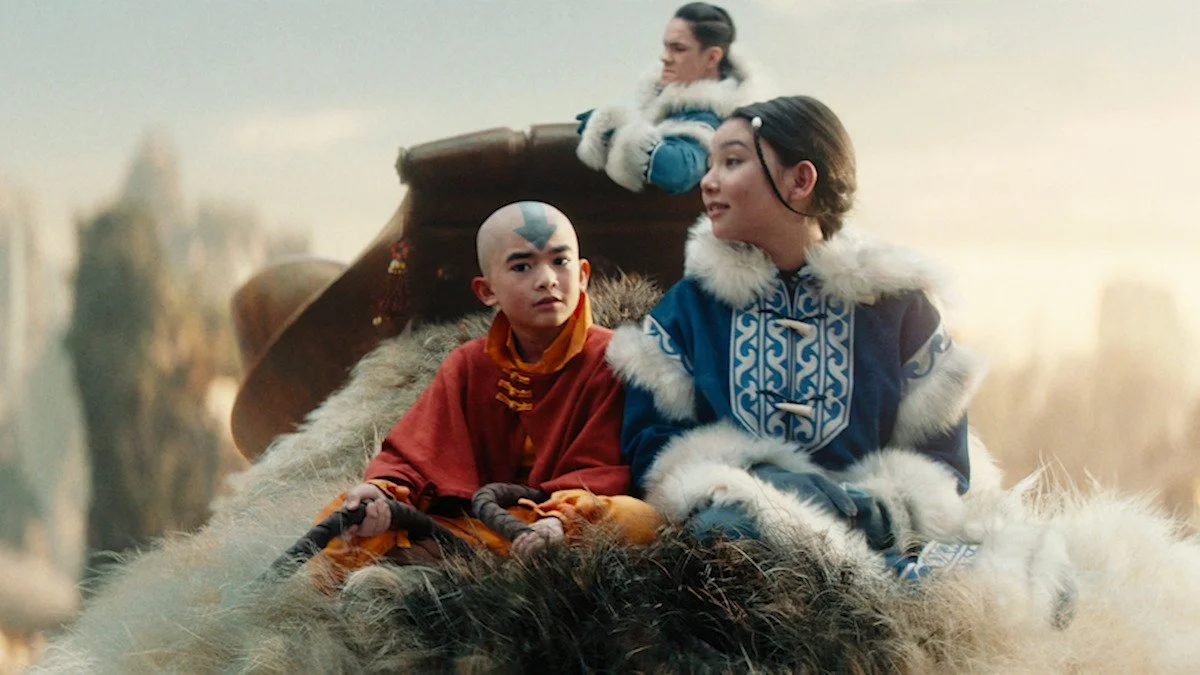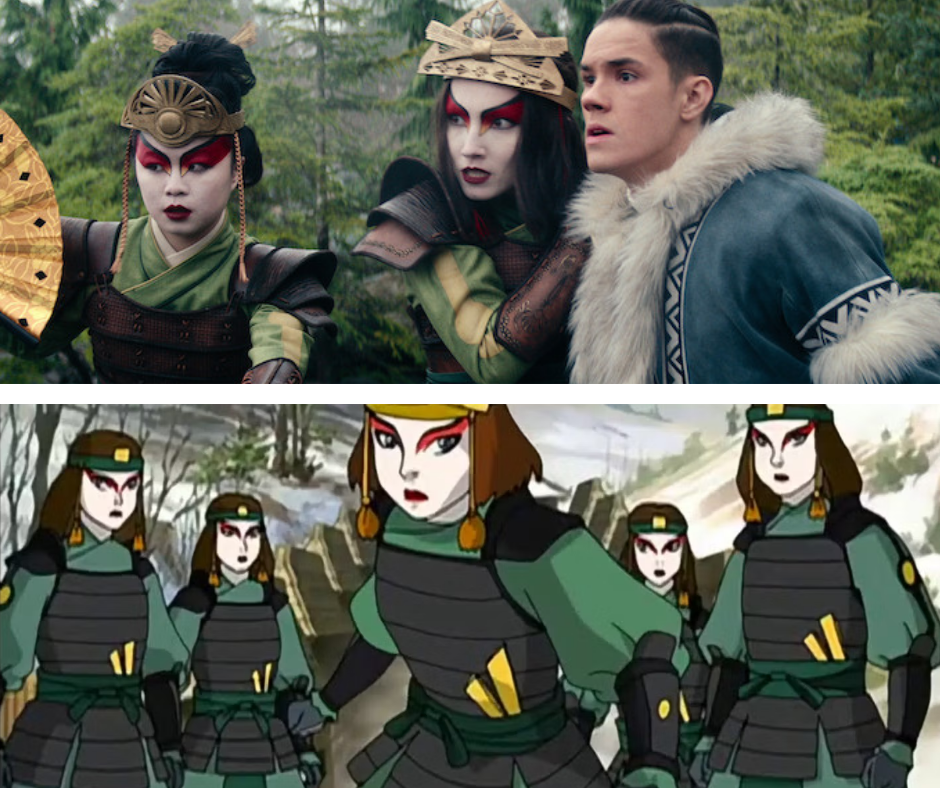Are there Any Adaptations That Aren’t Hated?
By Arts and Lit Editor Luca Cavallo
Netflix has finally released its live-action adaptation of Avatar: The Last Airbender. When I first heard the rumours about the project, I was thinking about my Leaving Certificate. Now, as a final-year student, it didn’t seem real that the adaptation, at long last, had finally arrived. It is only 8 episodes long, so I watched it; it was harmless fun. I respected the attention to detail in the set-designs and costumes, the air-bending went whoosh and the water-bending went splash. What’s not to like?
Well, people hated it!
Avatar: The Last Airbender. 2024, Dir. Jabbar Raisani.
After hundreds upon hundreds of botched adaptations, die-hard fans refuse to get their hopes up for anything these days. Indeed, thousands of man-children swarmed online to strike back at the evil forces (Netflix, in partnership with Nickelodeon) for committing heinous crimes (using CGI) to destroy their legacy (a cartoon). One fan stated that the blending of several small-scale stories from the original, animated series was a mess. Another fan said that Netflix ‘BUTCHERED’ the show, that they could have ‘kept the same storyline but noooooo.’ Unfortunately, the original Avatar was serialised in 20-25 minute episodes, which is quite unsuited to contemporary episode runtimes. It was only natural for the adaptation to condense many of the less vital scenes and characters into singular episodes. How this idea has been condemned as blasphemy is unfortunately beyond me.
The adaptation from animation to live-action is a dying trend. Actually, ‘dying’ implies that it was once ‘living’. I can’t recall a single live-action movie (adapting an animated source) that is halfway decent. In fact, I would even say that Avatar (2024) is the best of a bad, bad bunch (see its other adaptation, The Last Airbender (2011)). Disney tried to revitalise their audiences with nostalgia by adapting classics like Aladdin with a blue Will Smith and The Lion King with realistic, singing lions. These movies were unnecessary and confusing, to say the least.
The Kyoshi Warriors of Avatar: The Last Airbender. Above: 2024 Live-Action. Bottom: 2005 Original.
Perhaps the best-known form of adaptation is that from books to movies. This topic usually starts the debate of ‘which is better,’ rather than creating online mobs yelling ‘the adaptation BUTCHERED the novel’. That said, film adaptations of movies are often a little disappointing, if not underwhelming. A major reason for this is the limited content that can be transferred from page to screen. The dense, heavy novel has to be slimmed down into a screenplay, which is typically about 115 pages long. For example, I have never seen the adaptation of Donna Tartt’s The Goldfinch. Despite its 2.5-hour runtime, I just knew that there would be so much lost in the transition from such an enormous book into a Hollywood movie. Some respectable book adaptations include the Harry Potter series, the Hunger Games trilogy, The Devil Wears Prada, The Shining, One Flew Over the Cuckoo’s Nest, and Trainspotting.
So, if the adaptations of animated narratives leave viewers enraged, and the adaptations of novels leave viewers dissatisfied, is there a form of adaptation that both fans of the source material and a new audience may enjoy? Yes, kind of, maybe: the adaptation of graphic narrative.
I know the more recognisable terms are ‘graphic novel,’ ‘comic book’ or ‘manga’, but like the bigwig critics, I will put all of these under the bigwig umbrella term, graphic narrative. Maybe the best thing about adapting graphic narrative to film is that the source material is cinematic in its own respect. Graphic narrative has spent its entire lifetime doing its very best to replicate things like movement, speed, and sound. A lot of these actions come in the form of written, onomatopoeic sound effects, but there are also many examples of innovative styles to capture motion. This panel is from the highly popular Shonen manga, Naruto. We see two ninja fighting at superhuman speed, throwing flurries of shuriken. Do we know who has the upper hand? Who throws what? Which direction they’re moving? No. Is it cool? Yes. The explosive illustrations of Naruto therefore correspond to animation quite seamlessly. The chaotic nature of the manga panels is brought to life through equally chaotic sequences in its anime adaptation.
Above: Naruto (Manga). Below: Naruto (Anime)
In particular, manga-to-anime is a highly respected form of adaptation. It is expected of the animators to bring the still, colourless pages of manga to life with careful attention to the source material. In other words, the animators do what the man-child fans of Avatar wanted: replicating the sequence of the manga panels into the frames of animation. While you could say that this process eliminates any nuances in the transition between texts and media, the result remains satisfying. Consider the difference in effect between this panel, taken from Hajime Isayama’s Attack on Titan, and its subsequent adaptation. The original is visually striking, but the anime adds the crucial sounds of fire and explosion.
Of course, with such high standards among the manga community, which expects their favourite author’s work to be treated delicately and attentively, there comes great disappointment. Perhaps the most notorious example is the rather unfaithful adaptation of Tokyo Ghoul, which took great liberties to alter dark themes and add unnecessary ‘edginess’ to its protagonist, Kaneki. Consider this side-by-side comparison, which has since become a meme. I’m going to assume that the image speaks for itself.
The faithful adaptation of manga comes at a heavy cost. The use of CGI, which has been complained about in Avatar’s adaptation, is even more of a whinge-fest in anime adaptations. There are some considerably terrible examples, such as one of the many failed attempts to translate the highly detailed manga, Berserk. However, many studios will opt for CGI in scenes that are too difficult or costly to draw frame-by-frame under limited budget and time. The previously mentioned anime, Attack on Titan¸ used minimal amounts of CGI to animate the gargantuan titans in its fourth season, causing uproar among fans despite the otherwise stellar adaptation of the manga.
It seems that even the most faithful adaptations can fall victim to online controversy. It begs the question: Is adaptation necessary? Maybe the only way to avoid criticism in your adaptation is to push away from the idea of directly replicating the original text in another medium. Take Flanagan’s The Haunting of Hill House, for example, which pays homage to Shirley Jackson’s novel, but takes on its own story with its own, mostly new characters. Maybe we need to let go of our golden-age thinking, our belief that the original is always better. Appreciating the original and its adaptation as separate works with different contexts is easier said than done, but it is most likely the only way you won’t end up complaining on Twitter.




